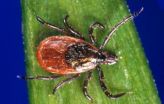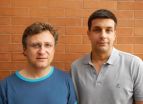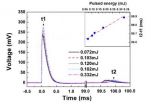(Press-News.org) WASHINGTON D.C., July 1, 2014 – Bacteria love to colonize surfaces inside your body, but they have a hard time getting past your rugged, salty skin. Surgeries to implant medical devices often give such bacteria the opportunity needed to gain entry into the body cavity, allowing the implants themselves to act then as an ideal growing surface for biofilms.
A group of researchers at the Shanghai Institute of Ceramics in the Chinese Academy of Sciences are looking to combat these dangerous sub-dermal infections by upgrading your new hip or kneecap in a fashion appreciated since ancient times – adding gold. They describe the results of tests with a new antibacterial material they developed based on gold nanoparticles in the journal Applied Physics Letters, from AIP Publishing.
"Implant-associated infections have become a stubborn issue that often causes surgery failure," said Xuanyong Liu, the team's primary investigator at the Shanghai Institute of Ceramics. Designing implants that can kill bacteria while supporting bone growth, Liu said, is an efficient way to enhance in vivo osteointegration.
Titanium dioxide is able to kill bacteria itself due to its properties as a photocatalyst. When the metal is exposed to light, it becomes energetically excited by absorbing photons. This generates electron-hole pairs, turning titania into a potent electron acceptor that can destabilize cellular membrane processes by usurping their electron transport chain's terminal acceptor. The membrane is gradually destabilized by this thievery, causing the cell to leak out until it dies.
The dark conditions inside the human body, however, limit the bacteria-killing efficacy of titanium dioxide. Gold nanoparticles, though, can continue to act as anti-bacterial terminal electron acceptors under darkness, due to a phenomenon called localized surface plasmon resonance. Surface plasmons are collective oscillations of electrons that occur at the interface between conductors and dielectrics – such as between gold and titanium dioxide. The localized electron oscillations at the nanoscale cause the gold nanoparticles to become excited and pass electrons to the titanium dioxide surface, thus allowing the particles to become electron acceptors.
Liu and his team electrochemically anodized titanium to form titanium dioxide nanotube arrays, and then further deposited the arrays with gold nanoparticles in a process called magnetron sputtering. The researchers then allowed Staphylococcus aureus and Escherichia coli to grow separately on the arrays -- both organisms were highly unsuccessful, exhibiting profuse membrane damage and cell leakage.
While silver nanoparticles have been previously explored as an antibacterial agent for in vivo transplants, they cause significant side effects such as cytotoxicity and organ damage, whereas gold is far more chemically stable, and thus more biocompatible.
"The findings may open up new insights for the better designing of noble metal nanoparticles-based antibacterial applications," Liu said.
INFORMATION:
Further research for Liu and his colleagues includes expanding the scope of experimental bacteria used and evaluating the arrays' in vivo efficacy in bone growth and integration.
The article, "Plasmonic gold nanoparticles modified titania nanotubes for antibacterial application" is authored by Jinhua Li, Huaijuan Zhou, Shi Qian, Ziwei Liu, Jingwei Feng, Ping Jin and Xuanyong Liu. It will appear in the journal Applied Physics Letters on July 1, 2014. After that date, it can be accessed at: http://scitation.aip.org/content/aip/journal/apl/104/26/10.1063/1.4885401
ABOUT THE JOURNAL
Applied Physics Letters features concise, rapid reports on significant new findings in applied physics. The journal covers new experimental and theoretical research on applications of physics phenomena related to all branches of science, engineering, and modern technology. See: http://apl.aip.org
Bringing the bling to antibacterials
Shanghai researchers develop new way to combat bacterial biofilm formation with titanium encrusted with gold nanoparticles
2014-07-01
ELSE PRESS RELEASES FROM THIS DATE:
Efforts to cut unnecessary blood testing bring major decreases in health care spending
2014-07-01
Researchers at Johns Hopkins Bayview Medical Center used two relatively simple tactics to significantly reduce the number of unnecessary blood tests to assess symptoms of heart attack and chest pain and to achieve a large decrease in patient charges.
The team provided information and education to physicians about proven testing guidelines and made changes to the computerized provider order entry system at the medical center, part of the Johns Hopkins Health System. The guidelines call for more limited use of blood tests for so-called cardiac biomarkers. A year after implementation, ...
Separating finely mixed oil and water
2014-07-01
CAMBRIDGE, Mass-- Whenever there is a major spill of oil into water, the two tend to mix into a suspension of tiny droplets, called an emulsion, that is extremely hard to separate — and that can cause severe damage to ecosystems. But MIT researchers have discovered a new, inexpensive way of getting the two fluids apart again.
Their newly developed membrane could be manufactured at industrial scale, and could process large quantities of the finely mixed materials back into pure oil and water. The process is described in the journal Scientific Reports by MIT professor Kripa ...
Mayo Clinic researchers reveal treasure trove of genes key to kidney cancer
2014-07-01
JACKSONVILLE, Fla. — A genomic analysis of clear cell renal cell carcinoma (ccRCC), the most common form of kidney cancer, from 72 patients has uncovered 31 genes that are key to development, growth and spread of the cancer, say researchers from Mayo Clinic in Florida. Eight of these genes had not been previously linked to kidney cancer, and six other genes were never known to be involved in any form of cancer.
MULTIMEDIA ALERT: Video and audio are available for download on the Mayo Clinic News Network.
Their study, in the journal Oncotarget, is the most extensive analysis ...
Alcohol use disorders linked to decreased 'work trajectory'
2014-07-01
July 1, 2014 - John D. Meyer, MD, MPH, of Icahn-Mount Sinai School of Medicine, New York, and Miriam Mutambudzi, PhD, MPH, of Johns Hopkins School of Medicine, Baltimore, studied the relationship between occupation and AUDs in workers followed up from early adulthood to middle age. The study focused on the "substantive complexity" of work as an indicator of work trajectory—whether individuals were progressing in their careers in terms of factors such as decision latitude and expanded work abilities.
Based on factors such as drinking more than intended or unsuccessful ...
NIH study reveals gene critical to the early development of cilia
2014-07-01
Researchers at the National Eye Institute (NEI) have described the functions of a gene responsible for anchoring cilia – sensory hair-like extensions present on almost every cell of the body. They show in a mouse model that without the gene Cc2d2a, cilia throughout the body failed to grow, and the mice died during the embryonic stage. The finding adds to an expanding body of knowledge about ciliopathies, a class of genetic disorders that result from defects in the structure or function of cilia. NEI is part of the National Institutes of Health.
The findings are published ...
Smartphone app may revolutionize mental health treatment
2014-07-01
Mental illness accounts for 90 percent of all reported suicides and places the largest burden of any disease on social and economic infrastructures worldwide, according to the World Health Organization. There is a dire need for support services to assist clinicians in the evaluation and treatment of those suffering from mental illness.
New technology developed by researchers at Tel Aviv University is poised to transform the way in which patients with mental illnesses are monitored and treated by clinicians. Dr. Uri Nevo, research team engineer Keren Sela, and scientists ...
Muscle-powered bio-bots walk on command
2014-07-01
Engineers at the University of Illinois at Urbana-Champaign demonstrated a class of walking "bio-bots" powered by muscle cells and controlled with electrical pulses, giving researchers unprecedented command over their function. The group published its work in the online early edition of Proceedings of the National Academy of Science.
"Biological actuation driven by cells is a fundamental need for any kind of biological machine you want to build," said study leader Rashid Bashir, Abel Bliss Professor and head of bioengineering at the U. of I. "We're trying to integrate ...
Reducing deer populations may reduce risk of Lyme disease
2014-07-01
Since white-tailed deer serve as the primary host for the adult blacklegged tick (Ixodes scapularis) — the vector for Lyme disease — scientists have wondered whether reducing the number of deer in a given area would also mean fewer cases of Lyme disease. Now, after a 13-year study was conducted, researchers in Connecticut have found that reduced deer populations can indeed lead to a reduction in Lyme disease cases. The results of their study are published in the Journal of Medical Entomology .
The researchers surveyed 90% of all permanent residents in a Connecticut ...
Enlightening cancer cells
2014-07-01
This news release is available in German.
Harald Janovjak, Assistant Professor at IST Austria, together with Michael Grusch, Associate Professor at the Institute of Cancer Research of the Medical University of Vienna, "remote-controlled" the behaviour of cancer cells with light, as reported this week in EMBO Journal (DOI: 10.15252/embj.201387695). This work is the first application of the new field of optogenetics to cancer research.
To understand the dynamics of cellular signaling, researchers need to activate and inactivate membrane receptor proteins, which ...
A new method to detect infrared energy using a nanoporous ZnO/n-Si photodetector
2014-07-01
Experiments aimed at devising new types of photodetectors have been triggered by the increasing use of optoelectronic devices in personal electronics, cameras, medical equipment, computers and by the military. Professor Zhao Kun and co-researchers at the State Key Laboratory of Petroleum Resource and Prospecting, part of the China University of Petroleum in Beijing, have proposed a new type of infrared photodetector.
Photodetectors, which can convert photons to electrical signals, are used to observe and measure the wavelength or energy of light, including infrared light, ...
LAST 30 PRESS RELEASES:
Sports injuries sustained during your period might be more severe
World's first successful 2 Tbit/s free-space optical communication using small optical terminals mountable on satellites and HAPS
Can intimate relationships affect your heart? New study says ‘yes’
Scalable and healable gradient textiles for multi‑scenario radiative cooling via bicomponent blow spinning
Research shows informed traders never let a good climate crisis go to waste
Intelligent XGBoost framework enhances asphalt pavement skid resistance assessment
Dual-function biomaterials for postoperative osteosarcoma: Tumor suppression and bone regeneration
New framework reveals where transport emissions concentrate in Singapore
NTP-enhanced lattice oxygen activation in Ce-Co catalysts for low-temperature soot combustion
Synergistic interface engineering in Cu-Zn-Ce catalysts for efficient CO2 hydrogenation to methanol
COVID-19 leaves a lasting mark on the human brain
Scientists use ultrasound to soften and treat cancer tumors without damaging healthy tissue
Community swimming program for Black youth boosts skills, sense of belonging, study finds
Specific depressive symptoms in midlife linked to increased dementia risk
An ‘illuminating’ design sheds light on cholesterol
Who is more likely to get long COVID?
Study showcases resilience and rapid growth of “living rocks”
Naval Research Lab diver earns Office of Naval Research 2025 Sailor of the Year
New Mayo-led study establishes practical definition for rapidly progressive dementia
Fossil fuel industry’s “climate false solutions” reinforce its power and aggravate environmental injustice
Researchers reveal bias in a widely used measure of algorithm performance
Alcohol causes cancer. A study from IOCB Prague confirms damage to DNA and shows how cells defend against it
Hidden viruses in wastewater treatment may shape public health risks, study finds
Unlock the power of nature: how biomass can transform climate mitigation
Biochar reshapes hidden soil microbes that capture carbon dioxide in farmland
Reducing saturated fat intake shows mortality benefit, but only in high-risk individuals
Manta rays create mobile ecosystems, study finds
Study: Mixed results in using lipoic acid to treat progressive multiple sclerosis
Norbert Holtkamp appointed director of Fermi National Accelerator Laboratory
New agentic AI platform accelerates advanced optics design
[Press-News.org] Bringing the bling to antibacterialsShanghai researchers develop new way to combat bacterial biofilm formation with titanium encrusted with gold nanoparticles




